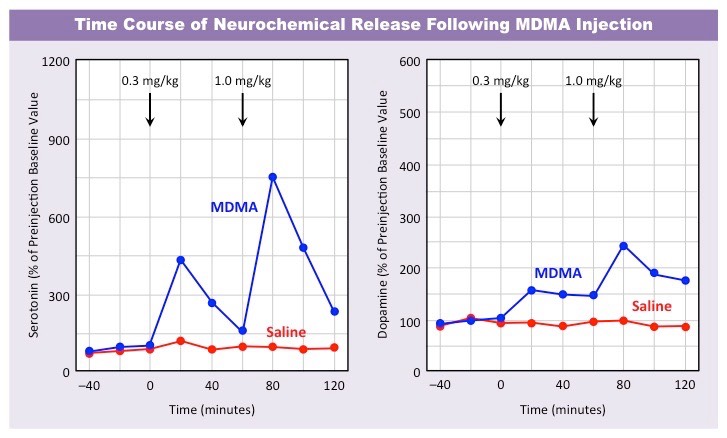![]()
Understanding:
• Psychoactive drugs affect the brain by either increasing or decreasing postsynaptic transmission
• Stimulant drugs mimic the stimulation provided by the sympathetic nervous system
Psychoactive drugs affect the brain and personality by either increasing or decreasing postsynaptic transmissions
- Drugs that increase neurotransmission levels are called stimulants and increase psychomotor arousal and alertness
- Drugs that decrease neurotransmission levels are called depressants and slow down brain activities and relax muscles
Stimulant drugs mimic the stimulation provided by the sympathetic nervous system (i.e. 'fight or flight’ responses)
- Examples of stimulants include caffeine, cocaine, amphetamines, ecstasy (MDMA) and nicotine
Depressants reduce stimulation of the central nervous system and may induce sleep (sedatives)
- Examples of sedatives include benzodiazepines, barbiturates, alcohol and tetrahydrocannabinol (THC = cannabis)

![]()
Application:
• Effects on the nervous system of two stimulants and two sedatives
Stimulants
1. Nicotine
- Nicotine stimulates the cholinergic pathways by mimicking the action of acetylcholine (binds Ach receptors)
- Nicotine is not broken down by the enzyme acetylcholinesterase, resulting in overstimulation of Ach receptors
- Nicotine raises dopamine levels in the brain (leading to addiction) and activates parasympathetic pathways (calming effect)
2. MDMA (ecstasy)
- MDMA binds to reuptake pumps on presynaptic neurons and blocks the recycling of dopamine and serotonin (5-HT)
- MDMA also enters the presynaptic neurons via the reuptake pumps and triggers the secretion of neurotransmitter
- This increases levels of neurotransmitter in the synaptic cleft, prompting feelings of euphoria and heightened sensation
Sedatives
1. Benzodiazepine
- Benzodiazepines bind to GABA receptors on the post-synaptic neuron and increase the efficiency of GABA action
- GABA triggers the opening of chloride channels to cause hyperpolarisation – benzodiazepines enhance this effect
- Benzodiazepines promote sleep-inducing and muscle relaxing responses by the body
2. Tetrahydrocannabinol (THC)
- THC mimics the neurotransmitter anandamide by binding to cannabinoid receptors on presynaptic neurons
- Anandamide (and THC) blocks the release of inhibitory neurotransmitters that prevent dopamine secretion
- By preventing the inhibition of dopamine secretion, THC causes a sense of euphoria and emotional well-being
Mechanism of Drug Action

![]()
Skill:
• Evaluation of data showing the impact of MDMA on serotonin and dopamine metabolism in the brain
MDMA (ecstasy) is a recreational drug known to increase the activity of specific neurotransmitters – serotonin and dopamine
- Serotonin (5-HT) is found in regions of the brain associated with sleep and emotion and is involved in regulating mood
- Dopamine is involved in the brain’s reward pathway and plays an important role in regulating motivation and pleasure
MDMA binds to reuptake pumps and increases the release of neurotransmitter whilst slowing its rate of uptake
- This causes an overstimulation of post-synaptic receptors until neurotransmitter reserves are depleted
- Long-term usage of MDMA can cause adverse changes to brain architecure and result in cognitive impairment
Effect of MDMA on Serotonin and Dopamine Activity
 Data:
Line Graph
Bar Graph
Data:
Line Graph
Bar Graph
Link: Mouse Party
